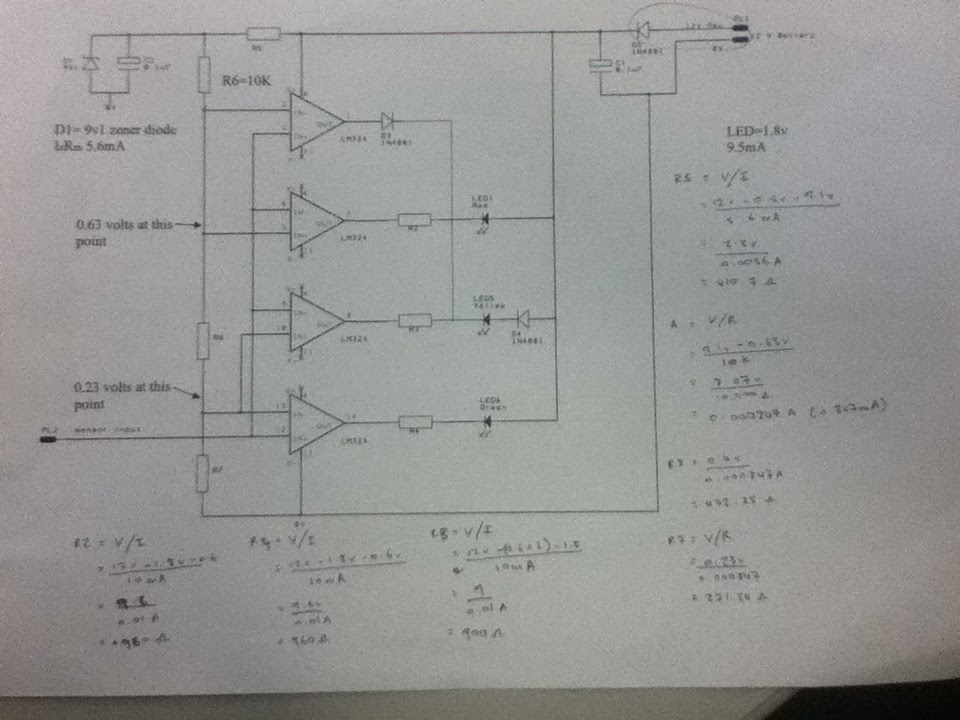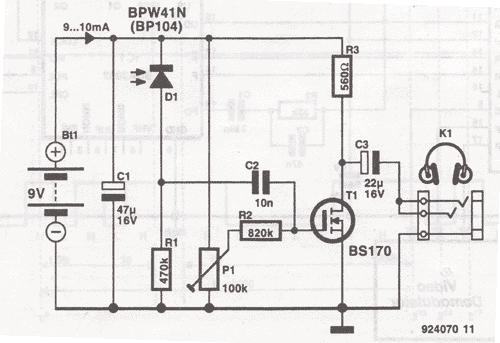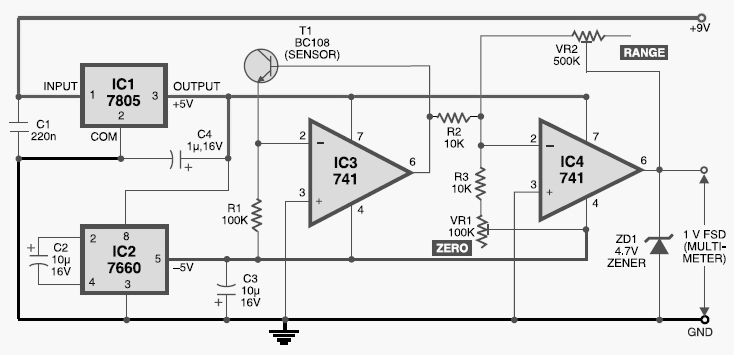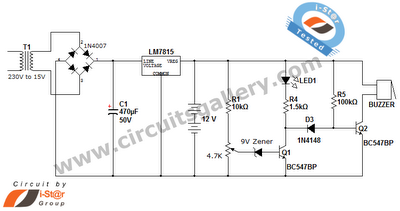
autotronics injector circuit

The diagram illustrates the connections for the inputs and outputs of each operational amplifier from the power source, detailing how each operational amplifier is configured to operate individual light-emitting diodes (LEDs). It also includes calculations for determining each resistor value, as discussed in a previous blog. The equipment was utilized to supply voltage to the sensor input of the oxygen sensor circuit, allowing for testing of the oxygen sensor circuit by adjusting one of the dials on the machine. This adjustment would send varying voltage signals to the sensor input, with the amount of voltage determining which part of the oxygen sensor circuit would activate. The machine was designed to simulate a vehicle's throttle, where increasing the dial simulates pressing the accelerator. Starting with a 12-volt power supply, voltage flows through a diode, resulting in an available voltage of 11.4 volts after a 0.6-volt drop across resistor R5 and the 9.1-volt zener diode and capacitor. The capacitors are included in the circuit to prevent voltage surges and maintain a steady voltage flow. From the power supply, after the diode, there is a connection to the op-amp before resistor R5, which connects to pin 4 of the op-amp, known as the positive voltage rail. The voltage from the zener diode flows to resistor R6, where only 9.1 volts is available. After this resistor, the voltage branches to pin 2 of the first op-amp and pin 5 of the second op-amp, yielding 0.63 volts at both pins due to the resistance in the circuit. Following R6, the voltage flows to resistor R8, connecting to pin 10 of the third op-amp and pin 13 of the fourth op-amp, resulting in an available voltage of 0.23 volts at both pins after a 0.4-volt drop. Each op-amp has an output pin, numbered 1, 7, 8, and 14, with pins 7, 8, and 14 connected to individual LEDs that receive a positive feed from the 12-volt power supply, leaving 11.6 volts available for each LED. However, pin 8 has another diode connected from the anode side of the LED. Resistors R2, R3, and R4 are placed between the output pins and the LEDs. Output pin 1 connects to a diode that links to pin 8 between the resistor and the LED on the cathode side. Each LED remains energized when the power supply is on. Pin 13, having a higher voltage, creates an output connection between pins 11 and 14, allowing the positive voltage from the power supply to ground, which activates the green LED. The yellow LED remains off due to insufficient voltage. When the sensor input voltage reaches approximately 3 volts at pin 9, it creates an output connection between pins 11 and 8, enabling voltage to flow from the power supply through the yellow LED to pin 8 and pin 11 to ground, thus activating the yellow LED and turning off the green LED. When the input voltage reaches around 0.7 to 0.8 volts, the red LED activates, as the voltage at pin 5 is lower than pin 6, creating a connection between pins 7 and 11 that allows the power supply voltage to ground and operate the red LED. The yellow LED remains off because pin 10's voltage is still higher. When the sensor input reaches 0.7 volts, the yellow LED switches off while the red LED is on. A fault in the oxygen sensor circuit was identified when only the yellow LED remained lit, regardless of adjustments to the sensor input voltage. Multimeter measurements revealed that the voltage after the diode was 11.4 volts, with consistent readings of 9.1 volts before and after resistor R6. However, measurements before resistor R8 showed only 1.8 millivolts, indicating a break in the circuit after input pin 5 and before resistor R8. This explained why the red LED would not activate, as there was always 9.1 volts at pins 2 and 5, making it impossible for the sensor to reach a high enough voltage without damaging the LED. Further measurements at pins 9 and 12 indicated a floating voltage of 8.2 millivolts, which kept the yellow LED on. The MOSFET functions similarly to a transistor, acting as a switch or voltage amplifier. The MOSFET has three terminals: Gate, Drain, and Source, differing from the bipolar junction transistor (BJT), which has Base, Collector, and Emitter terminals. The BJT requires high current to the Base to allow current flow, while the MOSFET requires voltage at the Gate. The N-Channel MOSFET operates like an NPN BJT, requiring positive voltage at the Gate to turn on, while the P-Channel MOSFET behaves like a PNP BJT, needing zero voltage at the Gate to allow current flow. The circuit comprises four operational amplifiers, three LEDs, three diodes, one zener diode, and seven resistors, all configured to create an oxygen sensor circuit. Resistor values were calculated using Ohm's law to ensure proper functioning of the circuit components.
The schematic represents a comprehensive oxygen sensor circuit utilizing operational amplifiers to manage LED indicators based on voltage inputs simulating sensor conditions. Each operational amplifier is configured to amplify the signal from the sensor input, with specific resistor values calculated to achieve desired voltage drops and ensure proper LED operation. The circuit design incorporates protection elements such as diodes and capacitors to maintain stable operation and prevent voltage spikes, enhancing reliability during testing scenarios. The use of MOSFETs further allows for efficient switching and control of the LED indicators based on the varying voltage levels received from the sensor input. Overall, this circuit design exemplifies a practical application of operational amplifiers and MOSFETs in automotive sensor technology, providing visual feedback through LEDs in response to sensor readings.The above diagram shows the different links to theinputs and outputs of each operational-amplifier from the power source and how each operation amplifier is wired to operate each seperate light emitting diode. Also shows calculations to obtaining each resistor value which is shown in previous blog. The above equipment was used to to supply voltage to the sensor input of the oxygen sensor circuit. This was used to test the oxygen sensor circuit by turning one of the dials on the machine which would send different votage signals to the sensor input, depending on the amount of voltage you turned the DC power supply would determine which circuit of the oxygen sensor would operate. This machine was used to simulate the throttle of a vehicle. the higher you turned the dial would simulate you putting your foot down on the accelerator. Starting with a 12 volt power supply voltage flows through the diode which leaves available vlotage of 11.
4 as it causes a 0. 6 voltage dropto the resistor (r5) to the 9. 1volt zener diode and capacitor. the capacitors are put in the circuit to prevent voltage surges and to keep a steady voltage flow. Also from the power supply, after diode it has a connection to the op-amp before the resistor (r5) to pin 4 of the op-amp, that is known as the positive voltage rain of the op-amp. From the zener diode it voltage flows to the next resistor (r6) but because of the zener thier is only 9.
1volts availabe. after the resistor it breaks off to pin 2 of the first op-amp and then pin 5 of the second op-amp, and because of the resistance put in the circuit we have 0. 63 volts available at both pin 2 and pin 5. In a straight connection after r6 and after pin 2 and pin 5 inputs voltage flows to the next resistor (r8) which then connects to pin 10 of the third op-amp and pin 13 of the fourth op-amp, and again because of adding the resistance created a 0.
4voltage drop so at pin 10 and pin 13 has available voltage of 0. 23 volts. Each op-amp has an output, those pins are numbered as pins 1, 7, 8 and 14. pins 7, 8 and 14 eachconnect to and individual LED which has a positive feed from the 12volt power supply after the diode which leaves 11. 6 volts available to each LED, but at pin 8 from the anode side of the LED has a another diode. Between the LED andoutput pins 7, 8 and 14 have resistors r2, r3 and r4. The output pin1 has and diode connected to it which connects to pin 8 in between the resistor and LED on the cathode side of the LED.
Each LED with the power supply on is hot at all times. since pin 13 is a higher voltage it creates an output connection between pin 11 and pin 14. so the positive voltage from the power supply to the LED will go to ground and doing so will switch the green LED on. The yellow will remain off as the voltage is not high enough at 9whichmeans thier is a connection from pin 4 to pin 8 and has a positive feed to to the cathode of the LED which keeps the yellow LED off while the green is on.
When the voltage at the sensor input reaches about roughly 3volts at pin 9 will create a output connection between pin 11 and 8 as the input voltage is higher than 0. 23volts at pin 13 which means voltage can flow from the power supply through the yellow LED to pin8 to pi 11 through to ground will will indeed operate the LED.
in doin this it will switch the green LED off as pin 12 will also have a 3volt input wihch is higher than 0. 23 volts at pin 13 which will create a connection between pin 4 and 14 which means positive voltage will flow from pin 14 to the cathode of the LED which will switch the LED off.
When the voltage reaches roughly 0. 7-0. 8volts will turn the red LED as thevoltage at pin 5 of the input is lower than the voltage of pin 6 which creates a connection between pin 7 and 11 which allows the voltage from the power supply to go to ground which should operate thered LED. As the input voltage at pin 9 is still higher than the input a pin 10 (op-amp used to switch yellow LED) the yellow LED should still remain on so we`ve connected output pin 1 between the yellow LED and the resistor.
when sensor inputs 0. 7 volts will switch on the LED and also create a connection between pin 4 and pin 1 which which allows positive voltage to flow from pin 1 to the cathode side of the yellow LED to switch it off while the red LED is on. I had another person create a fault in my oxygen sensor circuit. I called see it visualy but i wanted to know how that fault was affecting the circuit. So i attached it to the 12 volt power supply and found only the yellowLED remained on at all times no matter if you turned the sensor input voltageup or down.
So using a multimeter set on DC volts, I refered to the wiring diagram and went through the circuit looking at available voltages. From the power supply after the diode was 11. 4volts available. After r5 to the zener diode showed 9. 1volts which showed that part of the circuit was fine. Placed the meter before the r6 resistor which showed 9. 1 volts which is good then after r6 which showed 9. 1 volts again when it should have showed 0. 63. Than checked before resistor r8 and pin 10 and 13 which showed 1. 8milivolts which is next to nothing. In doing this check showed thier was a break after input pin 5 but before resistor r8. So this showed me why the red LED will not turn on as thier is always 9. 1 volts at pin 2 and 5 and the sensor will never reach that high of a voltage because if it did will blow the LED.
but was still confused why the yellow LED remained on the whole time. So again using the multimeter checked the available voltage at pin9 and 12 when the DC power supply is set at 0 volts a got a reading of 8. 2milivolts, which is known as floating voltage. Since that is still higher than the 1. 8 milivolts at pin 10 the yellow LED will remain on. -The MOSFET is used just like any other transistor where it can be used as a switch in a circuit or used to amplify voltage.
just like the Bipolar Junction Transistor (BJT) it has three main terminals. Where the terminals in the BJT are called Base, Collector and Emitter. The names change in the MOSFET, the terminals are the Gate, Drain and the Source. Also the difference between the BJT and the MOSFET is the BJT requires high current to the Base of the transistor to allow voltage to flow from the collector to the emitter where in the MOSFET it requires voltage at the Gate to allow voltage to flow from the Drain to the Source. The N-Channel Mosfet acts like a NPN bipolar junction transistor where the base of the BJT needs a positive feed to turn on the N-channel Mosfet requires positive voltage at the Gate to turn on.
The greater the Gate voltage the increases the size of the channel created. The P-Channel MOSFET acts like a PNP BJT where the PNP requires a negative feed to the base, so it requires zero voltage to allow voltage to flow the collector to the emitter the MOSFET requires zero voltage at the Gate to allow voltage to flow from the drain to the source but requires positive voltage to switch it off. These MOSFET`s can either be of a Depletion type where it requires voltage at the Gate to turn on or Enhancement type where the voltage at the Gate is used to turn the MOSFET on.
It has two input terminals and an output terminal and a negative and positive voltage rail. The positive input is known as the inverting terminal and the negative known as the non-inverting terminal and basically the op-amp amplifies the difference between the to inputs. The above digram shows four op-amps three LED`s three diode`s one zener diode and seven resistors all wired together to create an oxygen sensor circuit.
But before wiring the circuit together i have to find the values of different resistors to use in the circuit to produce different outputs at each op-amp. Firstly i find the resistor value which is after the power supply and diode so we will call that R5. Also taking not it has a 9. 1volt zener diode off that same circuit i created a formula using the ohm`s law. resistance = voltage/amperage. Also knowing the amperage required to operate the zener diode at 5. 6mA therefore Then going on to find the resistor values for r7 and r8 i have to find the amperage that will flow through as it is a parallel circuit and amperage may vary.
As r6 is already given as 10k (10, 000 ohms) and the available voltage after the zener diode is 9. 1volts and the available voltages given after each resistor 🔗 External reference
The schematic represents a comprehensive oxygen sensor circuit utilizing operational amplifiers to manage LED indicators based on voltage inputs simulating sensor conditions. Each operational amplifier is configured to amplify the signal from the sensor input, with specific resistor values calculated to achieve desired voltage drops and ensure proper LED operation. The circuit design incorporates protection elements such as diodes and capacitors to maintain stable operation and prevent voltage spikes, enhancing reliability during testing scenarios. The use of MOSFETs further allows for efficient switching and control of the LED indicators based on the varying voltage levels received from the sensor input. Overall, this circuit design exemplifies a practical application of operational amplifiers and MOSFETs in automotive sensor technology, providing visual feedback through LEDs in response to sensor readings.The above diagram shows the different links to theinputs and outputs of each operational-amplifier from the power source and how each operation amplifier is wired to operate each seperate light emitting diode. Also shows calculations to obtaining each resistor value which is shown in previous blog. The above equipment was used to to supply voltage to the sensor input of the oxygen sensor circuit. This was used to test the oxygen sensor circuit by turning one of the dials on the machine which would send different votage signals to the sensor input, depending on the amount of voltage you turned the DC power supply would determine which circuit of the oxygen sensor would operate. This machine was used to simulate the throttle of a vehicle. the higher you turned the dial would simulate you putting your foot down on the accelerator. Starting with a 12 volt power supply voltage flows through the diode which leaves available vlotage of 11.
4 as it causes a 0. 6 voltage dropto the resistor (r5) to the 9. 1volt zener diode and capacitor. the capacitors are put in the circuit to prevent voltage surges and to keep a steady voltage flow. Also from the power supply, after diode it has a connection to the op-amp before the resistor (r5) to pin 4 of the op-amp, that is known as the positive voltage rain of the op-amp. From the zener diode it voltage flows to the next resistor (r6) but because of the zener thier is only 9.
1volts availabe. after the resistor it breaks off to pin 2 of the first op-amp and then pin 5 of the second op-amp, and because of the resistance put in the circuit we have 0. 63 volts available at both pin 2 and pin 5. In a straight connection after r6 and after pin 2 and pin 5 inputs voltage flows to the next resistor (r8) which then connects to pin 10 of the third op-amp and pin 13 of the fourth op-amp, and again because of adding the resistance created a 0.
4voltage drop so at pin 10 and pin 13 has available voltage of 0. 23 volts. Each op-amp has an output, those pins are numbered as pins 1, 7, 8 and 14. pins 7, 8 and 14 eachconnect to and individual LED which has a positive feed from the 12volt power supply after the diode which leaves 11. 6 volts available to each LED, but at pin 8 from the anode side of the LED has a another diode. Between the LED andoutput pins 7, 8 and 14 have resistors r2, r3 and r4. The output pin1 has and diode connected to it which connects to pin 8 in between the resistor and LED on the cathode side of the LED.
Each LED with the power supply on is hot at all times. since pin 13 is a higher voltage it creates an output connection between pin 11 and pin 14. so the positive voltage from the power supply to the LED will go to ground and doing so will switch the green LED on. The yellow will remain off as the voltage is not high enough at 9whichmeans thier is a connection from pin 4 to pin 8 and has a positive feed to to the cathode of the LED which keeps the yellow LED off while the green is on.
When the voltage at the sensor input reaches about roughly 3volts at pin 9 will create a output connection between pin 11 and 8 as the input voltage is higher than 0. 23volts at pin 13 which means voltage can flow from the power supply through the yellow LED to pin8 to pi 11 through to ground will will indeed operate the LED.
in doin this it will switch the green LED off as pin 12 will also have a 3volt input wihch is higher than 0. 23 volts at pin 13 which will create a connection between pin 4 and 14 which means positive voltage will flow from pin 14 to the cathode of the LED which will switch the LED off.
When the voltage reaches roughly 0. 7-0. 8volts will turn the red LED as thevoltage at pin 5 of the input is lower than the voltage of pin 6 which creates a connection between pin 7 and 11 which allows the voltage from the power supply to go to ground which should operate thered LED. As the input voltage at pin 9 is still higher than the input a pin 10 (op-amp used to switch yellow LED) the yellow LED should still remain on so we`ve connected output pin 1 between the yellow LED and the resistor.
when sensor inputs 0. 7 volts will switch on the LED and also create a connection between pin 4 and pin 1 which which allows positive voltage to flow from pin 1 to the cathode side of the yellow LED to switch it off while the red LED is on. I had another person create a fault in my oxygen sensor circuit. I called see it visualy but i wanted to know how that fault was affecting the circuit. So i attached it to the 12 volt power supply and found only the yellowLED remained on at all times no matter if you turned the sensor input voltageup or down.
So using a multimeter set on DC volts, I refered to the wiring diagram and went through the circuit looking at available voltages. From the power supply after the diode was 11. 4volts available. After r5 to the zener diode showed 9. 1volts which showed that part of the circuit was fine. Placed the meter before the r6 resistor which showed 9. 1 volts which is good then after r6 which showed 9. 1 volts again when it should have showed 0. 63. Than checked before resistor r8 and pin 10 and 13 which showed 1. 8milivolts which is next to nothing. In doing this check showed thier was a break after input pin 5 but before resistor r8. So this showed me why the red LED will not turn on as thier is always 9. 1 volts at pin 2 and 5 and the sensor will never reach that high of a voltage because if it did will blow the LED.
but was still confused why the yellow LED remained on the whole time. So again using the multimeter checked the available voltage at pin9 and 12 when the DC power supply is set at 0 volts a got a reading of 8. 2milivolts, which is known as floating voltage. Since that is still higher than the 1. 8 milivolts at pin 10 the yellow LED will remain on. -The MOSFET is used just like any other transistor where it can be used as a switch in a circuit or used to amplify voltage.
just like the Bipolar Junction Transistor (BJT) it has three main terminals. Where the terminals in the BJT are called Base, Collector and Emitter. The names change in the MOSFET, the terminals are the Gate, Drain and the Source. Also the difference between the BJT and the MOSFET is the BJT requires high current to the Base of the transistor to allow voltage to flow from the collector to the emitter where in the MOSFET it requires voltage at the Gate to allow voltage to flow from the Drain to the Source. The N-Channel Mosfet acts like a NPN bipolar junction transistor where the base of the BJT needs a positive feed to turn on the N-channel Mosfet requires positive voltage at the Gate to turn on.
The greater the Gate voltage the increases the size of the channel created. The P-Channel MOSFET acts like a PNP BJT where the PNP requires a negative feed to the base, so it requires zero voltage to allow voltage to flow the collector to the emitter the MOSFET requires zero voltage at the Gate to allow voltage to flow from the drain to the source but requires positive voltage to switch it off. These MOSFET`s can either be of a Depletion type where it requires voltage at the Gate to turn on or Enhancement type where the voltage at the Gate is used to turn the MOSFET on.
It has two input terminals and an output terminal and a negative and positive voltage rail. The positive input is known as the inverting terminal and the negative known as the non-inverting terminal and basically the op-amp amplifies the difference between the to inputs. The above digram shows four op-amps three LED`s three diode`s one zener diode and seven resistors all wired together to create an oxygen sensor circuit.
But before wiring the circuit together i have to find the values of different resistors to use in the circuit to produce different outputs at each op-amp. Firstly i find the resistor value which is after the power supply and diode so we will call that R5. Also taking not it has a 9. 1volt zener diode off that same circuit i created a formula using the ohm`s law. resistance = voltage/amperage. Also knowing the amperage required to operate the zener diode at 5. 6mA therefore Then going on to find the resistor values for r7 and r8 i have to find the amperage that will flow through as it is a parallel circuit and amperage may vary.
As r6 is already given as 10k (10, 000 ohms) and the available voltage after the zener diode is 9. 1volts and the available voltages given after each resistor 🔗 External reference





